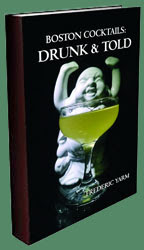 This month's Mixology Monday theme, "Retro Redemption!" (MxMo LXIII), was picked by Jacob Grier of the Liquidy Preference blog. Jacob's challenge was "to revive a drink from mixology's lost decades. Perhaps you feel one of these drinks has a bad rap; tell us why it deserves another shot. Or maybe the original concoction just needs a little help from contemporary ingredients and techniques to make it in the big leagues. If so, tell us how to update it."
This month's Mixology Monday theme, "Retro Redemption!" (MxMo LXIII), was picked by Jacob Grier of the Liquidy Preference blog. Jacob's challenge was "to revive a drink from mixology's lost decades. Perhaps you feel one of these drinks has a bad rap; tell us why it deserves another shot. Or maybe the original concoction just needs a little help from contemporary ingredients and techniques to make it in the big leagues. If so, tell us how to update it."When I read this theme, I immediately thought of a post I had wanted to do for a while. At Tales of the Cocktail 2010 at one of the informal tasting events, I had a chance to try Matt Rowley's Ratafia aux Noyau that was simply glorious. Like old fashioned crème de noyau, his was crafted from the aromatic and flavorful kernels of peach pits. Despite the glorious almond flavor from the stones, the FDA frowns upon the small amount of cyanide-creating compounds in them, and all crème de noyau is either distilled after infusion, such as Noyau de Poissy, or artificially flavored and colored, such as the bottom shelf bottles that these days only find their way into Alabama Slammers. Moreover, one of the talks I attended at Tales that year was "Bariana: the Golden Age of French Cocktails." In the classic French drink book Bariana, they called for dashes of noyau like Maloney called for apricot brandy bell-ringer rinses. My efforts for locating a bottle or scoring a sample of Noyau de Poissy were for naught, and in wanting to make some drinks from Bariana, I started harvesting peach pits to make Rowley's ratafia.
After a decent effort during peach season that year, I gathered up enough kernels to make a scaled down version of the recipe Rowley used from the Picayune's Creole Cook Book from 1910:
Peach Kernel RatafiaUnfortunately, the bottle of ratafia sat on the shelf for over a year until this event. The other thing that has sat around gathering dust is a box of powdered drink packets from my parents' house that Andrea and I rescued. While there is no date stamped, my guess is that they are from the late 1960s to mid 1970s. One of these glorious packets is for a Pink Squirrel. Pink Squirrels when mixed without a powdered packet require crème de noyau, so everything seemed to fall into place here.
• 1/3 oz Peach Kernels
• 5 1/3 oz Brandy
• 3 1/3 oz Sugar
• 2 2/3 oz Water
Pound the kernels along with some of the stones and steep them for a month in brandy. Add syrup made from sugar and water, mix, filter, and bottle.
Gary Regan in The Joy of Mixology traced the Pink Squirrel back to the 1966 edition of Old Mr. Boston and he claimed that the drink was still going strong when he bartended at New York's Drake's Drum in the mid 1970s. Gary provided the recipe as:
Pink SquirrelMade like this, the drink was not pink for our liqueur was not artificially colored, but it had a wonderful almondy and vanilla nose from the infusion. The sip was sweet and creamy, and the swallow was almondy and chocolate. Overall, it had the format of an Alexander and made for a decent dessert cocktail.
• 1 oz Crème de Noyau
• 1 oz White Crème de Cacao
• 1 oz Cream
Shake with ice and strain into a cocktail glass.

Pink SquirrelThe strangest part about this Pink Squirrel was that it smelled like Strawberry Quik. It was not almondy or chocolaty in the least. It was similarly creamy; however, it was not as sweet as expected despite additional sugar being added to a packet that listed sugar as its first ingredient. Just like it smelled, the swallow presented a very chemical Strawberry Quik taste. After a few sips shared between Andrea and me, this drink got sinked. Perhaps a better way to demonstrate the Pink Squirrel of that era would be to purchase bottom shelf liqueurs, but then I would have been stuck with them unless I somehow located nips of noyau or bombed the bottles later as a "gift" at a party.
• 1 1/2 oz Milk or Half & Half
• 1 tsp Sugar
• 1 Packet
• 1 1/2 oz Vodka
Shake or blend with ice. Strain into a cocktail glass. I stirred sugar, packet, and cream until dissolved. Added rest of ingredients and ice, shook, and strained into a cocktail glass.
Ingredients of Packet: sugar, natural flavors, artificial flavors, silicon dioxide, xanthan gum, artificial color.

 The 2017 collection of 855 drink recipes, bartender tributes, and essays on hospitality from CocktailVirgin's Frederic Yarm. Available at
The 2017 collection of 855 drink recipes, bartender tributes, and essays on hospitality from CocktailVirgin's Frederic Yarm. Available at  The 2012 collection of 505 drink recipes, techniques, and Boston bar recommendations from Frederic Yarm. Available at
The 2012 collection of 505 drink recipes, techniques, and Boston bar recommendations from Frederic Yarm. Available at 




No comments:
Post a Comment